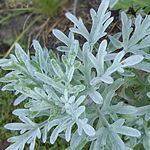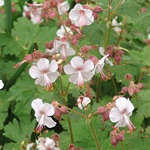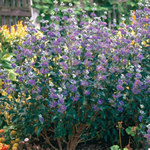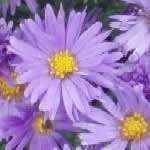SEARCH OUR PLANTS
To locate perennials by COMMON NAME, click on the first letter of the name below.
A • B • C • D • E • F • G • H • I • J • K • L • M • N • O • P • Q • R • S • T • U • V • W • X • Y • Z
|
Botanical / Common Name
|
Description
|
Photo
|
| Balloon Flower Platycodon grandiflorus 'Blaue Glocke' |
sun, part shade, groups, Summer blooming, 1-2 ft., blue flowers, Zone 5-8 | |
| Balloon Flower Platycodon grandiflorus 'Mariesii' |
sun, part shade, groups, Summer blooming, 1-2 ft., dark blue flowers, Zone 5-8 | |
| Balloon Flower Platycodon grandiflorus 'Misato Purple' |
sun, part shade, groups, Summer blooming, 1-2 ft., dark purple flowers, Zone 5-8 | |
| Barren Strawberry Waldsteinia geoides |
full-part shade, massing, good ground cover, 10 in., yellow flowers April-June, Zone 5-8 | |
| Barren Strawberry Waldsteinia ternata (W. trifolia, W sibirica) |
full-part shade, massing, good ground cover, 6 in., yellow flowers April-May, Zone 5-8 | |
| Barrenwort Epimedium grandiflorum 'Alba' |
This epimedium (sometimes commonly called large-flowered or longspur epimedium) is one of the larger epimediums. It is a dense, rhizomatous, clump-forming perennial which typically grows 10-12" tall and is primarily used in shady or woodland areas. 'Alba' produces racemes of long-spurred, white flowers in spring well above the foliage. Compound, medium green leaves with spiny-toothed, oval leaflets (to 3" long) on wiry stems form attractive foliage mounds. New leaves in spring emerge beige with a red tinge, mature to green and turn red in fall. This is a unique small area ground cover or edger for shady areas. It is also effective in partially shaded areas of rock gardens. Epimediums grow well under trees, as path edgers and even walkways that are shaded.
|
|
| Barrenwort Epimedium grandiflorum 'Lilafee' |
This epimedium is a charming petite barrenwort. It is a dense, rhizomatous, clump-forming perennial which typically grows 8-10" tall and is primarily used in shady or woodland areas. 'Lilafee' produces racemes of long-spurred, lavender-violet flowers in spring well above the foliage. Compound, medium green leaves with spiny-toothed, oval leaflets (to 3" long) on wiry stems form attractive foliage mounds. New leaves in spring emerge beige with a red tinge, mature to green and turn red in fall. This is a unique small area ground cover or edger for shady areas. It is also effective in partially shaded areas of rock gardens. Epimediums grow well under trees, as path edgers and even walkways that are shaded.
|
|
| Barrenwort Epimedium rubrum (E. alpinum var. rubrum) |
Rubrum is a robust Epimedum with dense, clump-forming foliage that grows 10”-12” tall.
|
|
| Barrenwort Epimedium versicolor 'Sulphureum' |
One of the most darling yet sturdy Epimediums. Flowers range from a soft butter yellow to almost “glowy” highlighter yellow and command attention when planted in mass in the shade. It is a hybrid of two Eurasian species, E grandiflorum and E. pinnatum colchicum. The display of foliage evolves over the season from bright green delicate leaves, speckled in ruby red and chocolate brown then turning more brilliant as autumn progresses. Soft yellow blooms top wire-thin stems in spring. Needs a shady spot for easy care; in sunnier locations, provide plenty of water
|
|
| Barrenwort Epimedium youngianum 'Niveum' |
This is a petite Epimedium but strong grower. It blooms a bit later in spring than other epimediums in absolutely pure white, short-spurred little flowers. They rise daintily just above a low mound of foliage. This is a tidy epimedium, not overwhelming to choice small bulbs and perennials within an integrated bed. True to its parentage, this Epimedium will slowly but surely grow in the dry, shady places where most other plants would quickly wither away.
|
|
| Barrenwort Epimedium youngianum 'Roseum' |
‘Roseum’ is lovely 6" groundcover to grow in the woodland garden, or shady border. Pretty, lavender-pink flowers dance above the foliage in springtime. This is a unique small area ground cover or edger for shady areas. It is also effective in partially shaded areas of rock gardens. Epimediums grow well under trees, as path edgers and even walkways that are shaded.
|
|
| Beach Wormwood Artemisia stelleriana |
Wide 1" felty silver foliage with a hint of green coloring. Upright open form. Softens color transitions in the border. Do not cut into old wood - look for buds to start and do not cut below that. Can be sheared during the summer if needed - new foliage will flush out quickly. Prized for their silver leaves, excellent texture and vigorous growth. They do not flower conspicuously, but are used for their contrasting foliage.
|
|
| Beard Tongue Penstemon digitalis 'Husker Red' |
sun, part shade, groups, Summer blooming, 1996 PPA Plant of the Year, 2-3 ft., white bell flowers, bronze-purple foliage, Zone 4-9 | |
| Beard Tongue Penstemon hirsutus |
sun, part shade, groups, Summer blooming, 2-3 ft., violet flowers, dry conditions, native to East USA, Zone 4-9 | |
| Beard Tongue Penstemon hirsutus 'Pygmaeus' |
sun, part shade, groups, Summer blooming, 6 in. high, violet flowers, blooms June-Aug, Zone 4-9 | |
| Beard Tongue Penstemon strictus |
sun, part shade, groups, Summer blooming, 2 ft., blue-violet flowers, July-Aug., Zone 4-9 | |
| Bear's Breech Acanthus 'Caroli- Alexandri' |
Despite the boldness of its leaves, which have deeply cut and pointed margins, it is a compact grower, at home even in a large container. In full sun, bear’s breeches produces equally dramatic, pagoda-like inflorescences, up to three feet tall. These are composed of tiers of hooded flowers. Each flower has a sharp spine, so be careful when handling them. Because bear’s breeches grows well in sun or part shade.
|
|
| Bear's Breech Acanthus hungaricus |
Tolerates wide range of soils except poorly-drained ones. Appreciates some afternoon shade in hot summer climates. An erect, clump-forming perennial which features pale pink to white flowers enclosed in spiny, reddish-purple bracts and arranged in vertical rows on substantial flower spikes rising well above the foliage to 3-4' tall. Blooms in late spring to early summer. Deeply lobed glossy green leaves (2-3' long) form an ornamental mound which usually remains attractive throughout the growing season.
|
|
|
Bear's Breech
|
May not flower well in too much shade. Late spring frosts can impair or eliminate flowering for the year. Remove flowering stalks after bloom. In cold winter areas, plant foliage should be left in place over winter but removed in early spring as new foliage appears. Plants can spread aggressively by creeping rootstocks, particularly in loose soils. This species of bear’s breeches is a clump-forming perennial that is grown as much for its attractive foliage as for its architecturally bold white flower spikes with rich purple hoods.
|
|
| Bear's Breech Acanthus spinosus |
Blooms from late spring into mid summer. Deeply-cut, arching, glossy green, spiny, thistle-like leaves (2-3' long) form an ornamental mound of long-stalked, basal foliage which usually remains attractive throughout the growing season. The leaves of A. spinosus are more deeply cut and have rigid spines (hence the species name) at the lobe tips than other Acanthus. The Acanthus leaf has a classic appearance and are the source of the Corinthian leaf motif developed and used as a decoration in ancient Greek and Roman art and architecture.
|
|
| Beauty Aster Asteromoea mongolica (Kalimeris m. ) |
2-3 ft., white flowers during summer, Zone 4-8 | |
| Bee Balm Monarda 'Blaustrumpf' 'Blue Stocking' |
sun, massing, Summer blooming, 4-5 ft., purple flowers, mildew resistant , Zone 4-9 | |
| Bee Balm Monarda 'Cambridge Scarlet' |
sun, massing, Summer blooming, 4-5 ft., red flowers , Zone 4-9 | |
| Bee Balm Monarda 'Colrain Red' |
sun, massing, Summer blooming, 3' Strikely red blooms with the smallest hint of yellow in June-July. Resistance to mildew is high, Zone 4-9 | |
| Bee Balm Monarda 'Croftway Pink' |
sun, massing, Summer blooming, 4 ft., pink flowers , Zone 4-9 | |
| Bee Balm Monarda 'Donnerwolke' 'Thunder Cloud' |
sun, massing, Summer blooming, 3 ft., purple-red flowers, Zone 4-9 | |
| Bee Balm Monarda fistulosa |
sun, massing, Summer blooming, 3 ft., pink to lavender purple flowers, dry, full sun to part shade, attractive to butterflies & hummingbirds, native to eastern USA, blooms June-July, Zone 3-8 | |
| Bee Balm Monarda ‘Jacob Cline’ |
sun, massing, Summer blooming, 5 ft., large red flowers with dark red brachts appearing mid-Summer, stems produce dark green mildew free foliage, Zone 4-9 | |
| Bee Balm Monarda 'Kardinal' |
sun, massing, Summer blooming, 3 ft., red flowers, Zone 4-9 | |
| Bee Balm Monarda 'Mahogany' |
sun, massing, Summer blooming, 3 ft., maroon-purple flowers, Zone 4-9 | |
| Bee Balm Monarda 'Marshall's Delight' |
sun, massing, Summer blooming, 3 ft., bright pink flowers, mildew resistant, Zone 4-9 | |
| Bee Balm Monarda 'Purpurkrone’ ‘Purple Crown' |
sun, massing, Summer blooming, 2-3 ft., purple flowers, Zone 4-9 | |
| Bee Balm Monarda 'Snow White' |
sun, massing, Summer blooming, 3' Although foliage & blooms are smaller in comparison, there is nothing stopping the show of pure white blooms in June-July, Zone 4-9 | |
| Bee Balm Monarda 'Squaw' |
sun, massing, Summer blooming, 2-3 ft., red flowers, Zone 4-9 | |
| Bell Flower Campanula carpatica 'Blaue Clips' |
One of the most popular Bellflowers. Plants form a low, cushion-shaped mound of small green leaves, with loads of upfacing, open bells appearing in early summer. This selection has flowers in a clear medium-blue shade. Will continue blooming for weeks if spent blossoms are regularly removed. Excellent choice for the rock garden, edging and in containers. Performs especially well in regions with cool nights during the summer. Plants should be divided every 2 to 4 years, in spring or fall.
|
|
|
Bigroot Geranium |
sun, part shade, massing, 1 ft., pink flowers blooming May-June, good ground cover, scented leaves, Zone 5-8 | |
| Bigroot Geranium Geranium macrorrhizum ‘Bevans Variety’ |
sun, part shade, massing, 1 ft., magenta flowers, Zone 5-8 | |
| Bigroot Geranium Geranium macrorrhizum 'Ingwersen's Variety' |
sun, part shade, massing, 1-2 ft., pink flowers, Zone 5-8 | |
| Bigroot Geranium Geranium macrorrhizum 'Purpurrot' |
sun, part shade, massing, 1-2 ft., purplish-red flowers, Zone 5-8 | |
| Bigroot Geranium Geranium macrorrhizum 'Spessart' |
sun, part shade, massing, 1 ft., pale pink flowers, almost white, Zone 5-8 | |
| Black-Eyed Susan Rudbeckia fulgida'Goldsturm’ |
sun, borders, groups, Summer-Fall blooming, 1999 PPA Plant of the Year, 3 ft., gold flowers with black eyes, Zone 5-8 | |
| Blackberry Lily Belamcanda chinensis |
2 ft., orange flowers, June-Aug, sun,sandy soil Zone 6-8 | |
| Blackberry Lily Pardancanda norrisii |
2-3 ft., multicolored flowers in June, very choice, sun, Zone 6-9 | |
| Blackberry Lily Pardancanda norrisii 'Dazzler' |
12-16", dazzling oranges, pinks, purples & reds blooming June-Sept. Full sun-partial shade, Zone 5-9 | |
| Bleeding Heart Dicentra formosa 'Bacchanal' |
Dicentra can be rhizomatous or tuberous perennials with attractively divided leaves and pendent, heart-shaped flowers, usually in arching panicles or racemes. 'Bacchanal' is a spreading rhizomatous perennial with finely divided grey-green leaves and short racemes of nodding, deep crimson flowers in late spring and early summer. Perfect for the cottage garden. . It is deer resistant.
|
|
| Bloodroot Sanguinaria canadensis |
6 in., white flowers in early Spring, shade, massing, Zone 4-8 | |
| Bluebeard Caryopteris clandonensis 'Azure' |
2-4 ft., silvery foliage, sun, dry locations, groups, blooms Summer-Fall, light blue flowers, Zone 6-9 | |
| Blue False Indigo Baptisia x. 'Purple Smoke' |
Apparently a chance hybrid of B. australis and B. alba. It has the dark charcoal-gray stems of alba and the blue color from australis. It is, in our opinion a different purple than B. australis but a nice hue. It blooms May-June in full sun as its parent does with all of the same wonderful habits. Native – deer resistant.
|
|
| Blue Flag Iris Iris versicolor |
sun, moisture loving. 3 ft., blue-purple flowers May-June, needs wet areas, Zone 4-9 | |
| Blue Flag Iris Iris versicolor ‘Kermesina’ |
sun, moisture loving, 20-24 in., red flowers, blooms in June, Zone 4-9 | |
| Blue Lagoon Aster dumosus 'Blaue Lagune' |
sun, massing, blooms early Fall, 2 ft., clear blue flowers in Summer, part shade, Zone 4-8 | |
| Blue Wood-Aster Aster coridfolius |
Size: 2 ½’ x 2 ½’, sun - shade (flowers in 3+ hours of sun),
Native. Soft flowers in early fall in shade. Handsome planting under trees or at wood’s edge for
softening. Pairs nicely with Astilbes or as the third-season filler around Hostas in a woodland
garden. Naturally found in woods and dry meadows with one inch flowers that cover the tops of the tall
plants from a dark blue to a slightly pale blue almost white with yellow centers. Unlike the
wildform, this variety is upright and attractive with heart shaped lower leaves. Nice cut flower for
fall. Excellent choice for meadow plantings. Zone 5-8
|

click to enlarge |
| Bowman's Root Gillenia trifoliata |
3 ft., white star like flowers, delicate airy looking, tall branching stems, blooms July-Aug, Zone 4-9 | |
| Bridal Veil Astilbe arendsii hybrid 'Brautchleier' |
part shade, massing, groups, 2-3 ft., white flowers in June, Zone 5-8 | |
| Bugbane Cimicifuga ramosa |
A stately plant with airy wands of ivory-white flowers in summer towering over the gorgeous dark green foliage with purple/chocolate stems. Though it can reach 4 to 7 feet tall, it does not need staking. Excellent nectar and pollen source for beneficial insects and an important host plant for Appalachian blue and spring azure butterfly. It blooms in shade for over 4 weeks and will grow in the dry soil even under hardwood trees. It is long-lived, tough and easy to grow. C. racemosa.
|
|
| Bugbane Cimicifuga racemosa var. cordifolia |
This Cimicifuga is a good plant for the mid to back of border and is highly adaptable It is even perfect for damp, poorly drained soil or even soil that becomes dry. It is attractive near a water feature, pond or stream. It bears fragrant creamy-white flowers in the fall. There is some contention that this named variety may be Cimicifuga Americana; they are likely synonymous.
|
|
| Bugbane Cimicifuga ramosa 'Brunette' |
Intense purple leaves have fragrant white bottlebrush flowers are produced in fall. Excellent for late season color. Because Cimicifuga is deer resistant it is very attractive in a woodland garden or at the wood’s edge. C. racemosa ‘Brunette’
|
|
| Bugle Weed Ajuga pyramidalis 'Metallica Crispa' |
Attractive evergreen ground cover with colorful foliage and spikes of blue flowers in spring. Crinkly foliage is bronze/burgundy with a metallic sheen. Spikes of deep blue flowers in spring. Unique alternative to some of the more traditional ground cover colors because of its richness and shiny foliage.
|
|
| Bugle Weed Ajuga reptans 'Alba' |
Rare and not easily available in today’s market, this semi-evergreen ground cover is beautiful with its rich medium green foliage and upright white flowers. This unique ground hugging evergreen is most useful for light shady ground-cover. The white flower spikes appear in the spring and early summer.
|
|
| Bugle Weed Ajuga reptans 'Burgundy Glow' |
Noted for the striking range of foliage colors and textures. 'Burgundy Glow' features tricolored foliage of white, pink and green with blue flowers on 6" spikes in late spring. In mass plantings, the flower effect can be very dramatic and quite painterly. True for all A. reptans, it is easy to grow and easy to transplant. It prefers a well-drained shady location but also performs well in sunny areas. Soil should contain organic matter. A light, early spring fertilization is sufficient. Spreads rapidly.
|
|
| Bugle Weed Ajuga reptans 'Jungle Beauty' |
This evergreen ground cover adds interest to shady areas. A European native that spreads rapidly by stolons to form a dense carpet of vegetation. Spikes of pretty dark to medium blue flowers appear in late spring and early summer through the bronze and green-leaves. It can be tolerant of poor soils but perform best in those that are evenly moist and well drained. Divide plantings every two to three years to prevent overcrowding and possible disease problems. True for all A. reptans, it is easy to grow and easy to transplant. It prefers a well-drained shady location but also performs well in sunny areas. Soil should contain organic matter. A light, early spring fertilization is sufficient. Spreads rapidly.
|
|
| Bugle Weed Ajuga reptans 'Mahogany' |
Mahogany bugleweed is an evergreen to semi-evergreen, perennial groundcover with glossy leaves of dark burgundy to black. Typical Ajuga reptans needs and habit. True for all A. reptans, it is easy to grow and easy to transplant. It prefers a well-drained shady location but also performs well in sunny areas. Soil should contain organic matter. A light, early spring fertilization is sufficient. Spreads rapidly.
|
|
| Bugle Weed Ajuga tenorii 'Chocolate Chip' |
This is just the sweetest little, tight mounds of rich chocolate, purple thumb-sized and shaped foliage for the A. tenorii ‘Chocolate Chip’. It is the smallest Ajuga on the market. The deep blue flowers on 2 inch spikes help make this one of the most attractive ground covers for any landscape with some shade. It will tolerate light foot traffic between pavers as well along borders, trees and shrubs. Not ideal for a path cover that will be tread frequently.
|
|
| Butterbur Petasites albus |
attractive large foliage, part shade, moisture loving, blooms early Spring, 3-4 ft., white flowers, invasive, Zone 4-9 | |
| Butterbur Petasites japonicus |
attractive large foliage, part shade, moisture loving, blooms early Spring, 3-4 ft., purple flowers, good for pond edges, Zone 5-9 | |
| Butterfly Bush Buddleia 'Attraction' |
So far, the reddest butterfly bush that we’ve seen. It is open, airy, vase-shaped shrub shoots up 6 to 8 feet tall and wide if left to its own devices. Benefits from severe pruning/cutting back in late. Cut spent flowers before they go to seed to encourage repeat flowering. The blooms will appear refreshed on foot or more long wands, arching in all directions on sturdy stems. The fragrance is sweetly evocative of summer and the brilliant color is radiant. 'Attraction' breaks new ground with rich cranberry-red.
|
|
| Butterfly Bush Buddleia 'Black Knight' |
The darkest purple and a very old variety that is a breeze to grow. It is a atall and stately shrub with extremely dark purple booms that are complimented by a rich dark green foliage. Against a clear blue summer sky, the wands of profuse flowers appear as a black silhouettes and thusly named Black Knight.
|
|
| Butterfly Bush Buddleia ‘Pink Delight’ |
This gentle pink butterfly bush seems to be a magnet for the Sphinx moth or hummingbird moth. Among the butterflies and bumble bees, the moth hovers over this shrub for most of the day. This shrub is not only attractive in form but also mildly fragrant. It has a gentle pink color that fades into an almost white throat with a golden eyed center.
|
|
| Butterfly Bush Buddleia ‘Royal Red’ |
Not really red but the redder hue of the purple color range appears in these flowers. It certainly is royal with its pink lobes and orange centers. It has a relaxed habit which keeps it from getting as tall as some of the B. davidii. Flower stems appear in clusters of threes with the largest in the middle and bloom from the bottom of the flower wand up and outward.
|
|
| Butterfly Bush Buddleia ‘White Profusion’ |
White Profusion is a large stately beacon to butterflies and beneficial insects. It is a good clear white flower that blooms from late spring through late summer. It has soft silvery undersides on its leaves which complement the white of the flowers. Significantly taller than other butterfly bushes.
|
|
| Butterfly Weed Asclepias tuberosa |
2-3 ft., orange flowers, sun, border, native, Zone 4-8 | |























































































